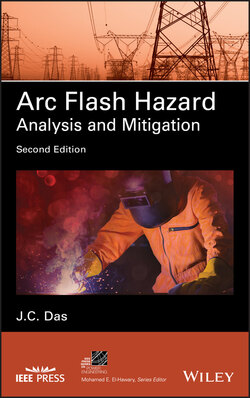Читать книгу Arc Flash Hazard Analysis and Mitigation - J. C. Das - Страница 16
1.1 ELECTRICAL ARCS
ОглавлениеElectrical arcing signifies the passage of current through what has previously been air. It is initiated by flashover or introduction of some conductive material. The current passage is through ionized air and the vapor of the arc terminal material, which has substantially higher resistance than the solid material. This creates a voltage drop in the arc depending upon the arc length and system voltage. The current path is resistive in nature, yielding unity power factor. Voltage drop in a large solid or stranded conductor is of the order of 0.016–0.033 V/cm, very much lower than the voltage drop in an arc, which can be of the order of the order of 5–10 V/cm of arc length for virtually all arcs in open air (Chapter 3). For low voltage circuits, the arc length consumes a substantial portion of the available voltage. For high voltages, the arc lengths can be considerably greater, before the system impedance tries to regulate or limit the fault current. The arc voltage drop and the source voltage drop are in quadrature. The length of arc in high voltage systems can be greater and readily bridge the gap from energized parts to ground.
Under some circumstances, it is possible to generate a higher energy arc from a low voltage system, as compared with a high voltage system.
In a bolted three-phase short circuit, the arcing resistance is zero, and there is no arcing, and no arc flash hazard. Sometimes, when short circuit occurs, it can be converted into a three-phase bolted short circuit by closing a making switch or circuit breaker, which solidly connects the three-phases. The fault current is then interrupted by appropriate relaying. This method, however, will subject the system to much greater short-circuit stresses and equipment damage, and, is, therefore, not recommended.
